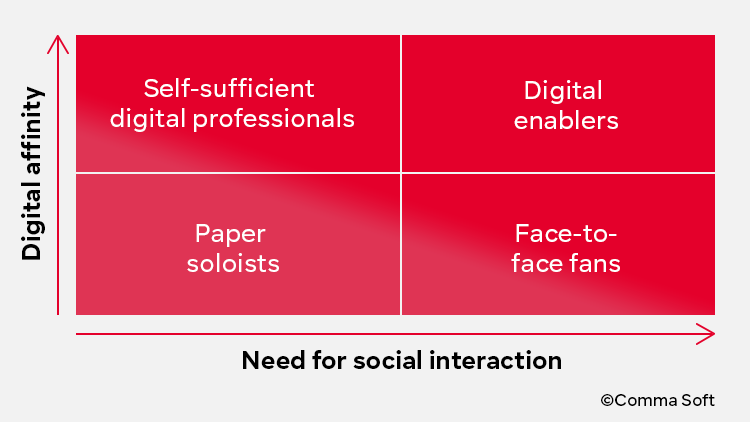
From paper soloist to digital enabler: introducing people-centric digitization measures
More and more companies today want to be digital, data-driven, and AI-powered while offering their employees a modern work environment. Change & adoption management are essential elements on the way to achieving this. But what is the best way to get employees on board? Companies can figure this out and implement the right measures using the types of digitization presented here.
Just about every company is now going digital. However, the degree of digitization and the role played by data varies. Companies that want to reach the next level in this respect are faced with more than just the challenges of introducing suitable technologies, preparing data, adapting processes and modernizing workplaces. Employees play a central role in all of this: if they do not accept innovations such as AI-supported assistants, automated processes and new collaboration tools, digitization efforts will come to nothing in the long run. Successful strategies therefore incorporate change & adoption management into the agenda from the outset. The question is, which measures will best facilitate change for employees? Since everyone has different needs and brings different digital capabilities to the table, it’s important to understand them first. Only then can suitable measures be derived. Two key criteria are digital affinity and the need for – real or indeed virtual – social interaction. The following four types of digitization can be identified on the basis of these two characteristics, for instance through surveys.

1. Digital enablers
Employees who already feel at home in digital environments and can work even more productively through social interaction usually quickly find their way around new applications and digital processes. Their expertise helps them appreciate the benefits of working (collaboratively) in digital formats. In most cases, short tutorials on new tools or hints about features integrated into the applications are enough to let them jump right in. Many of these employees also have multiplier potential: they enjoy contributing input even in an agile development phase, testing new solutions as key users and explaining them to their colleagues. Their enthusiasm can therefore easily spread to others and boost confidence in the innovations.
2. Self-sufficient digital professionals
Employees in this group are certainly not lacking in technical expertise either. They, too, will tend to familiarize themselves quickly with the workings of new solutions. Since they have a less pronounced need for social contact and prefer to acquire new knowledge on their own, specific guides, fact sheets and technically oriented demo videos are particularly suitable for them as change & adoption measures. This group can also actively support the change process – they can find shortcuts that make work easier for others, for example, identify potential for technical improvements and possible solutions. This knowledge can be made available and used in a straightforward manner, for example in wikis or FAQs. A targeted, personal approach to these employees helps to ensure that this actually happens and that ideas are shared with everyone.
3. Face-to-face fans
Those who have a strong need for social interaction and at the same time are less familiar with digital innovations also benefit from human interaction when introducing new digital solutions: live training, direct contact partners, and open consultation hours – e.g., with colleagues in the first group – make the change process easier for them and convey a sense of certainty. In the age of hybrid work models, these measures can also be carried out in a hybrid form: a familiar presence environment creates a sense of certainty, while shared virtual measures enable user-friendly, appreciative familiarization with new tools. Chat and telephone support are additional ways of involving these employees and strengthening their digital literacy.
4. Paper soloists
Employees who previously preferred to rely on analog processes and paper documents often face a major challenge when switching to digital solutions. What’s more, if they work most productively on their own, multipliers and measures aimed at personal interaction have less of an impact. What this group needs is intensive yet sensitive, unobtrusive support: on-demand tutorials, wikis and FAQs can be used by these employees at their own pace. Background information on the reasons for, process of, and effects of changes also provides this group in particular with a sense of security and reduces any concerns that may exist. What fears are associated with the upcoming change? What do these employees need if they are not only to get involved with new processes and solutions, but also to be happy to use them in the future? It is worthwhile to get to the bottom of such questions together and to shape change deliberately. Personal rites of passage or self-reflection with a neutral coach can also help here.
Finding the right mix of measures
Successful change & adoption management relies on a mix of different measures that engage the various groups involved based on their respective knowledge and needs. It also takes into account other factors, such as employees’ willingness to change, their individual workplace design, team compositions, and much more. It is important not to impose ready-made solutions on employees. They should be involved from the outset and their concerns should be taken seriously. If they can help shape the change and feel valued for their ideas, the likelihood of acceptance is great. Companies or project teams should also be able to provide clear answers as to why new solutions and processes are being introduced, what the exact process of the changeover looks like, what impact all this has on the work of both individuals and teams, and what benefits can arise from it. Answering such questions and finding suitable measures for change & adoption is often even easier and more focused when viewed from a neutral outside perspective. Comma Soft’s consultants are happy to act as sparring partners and can also contribute best practices from numerous projects.
If you would like support with the introduction of new technologies and the associated change processes, Comma Soft’s experts will be happy to assist you. You can contact us here for an initial non-binding consultation.